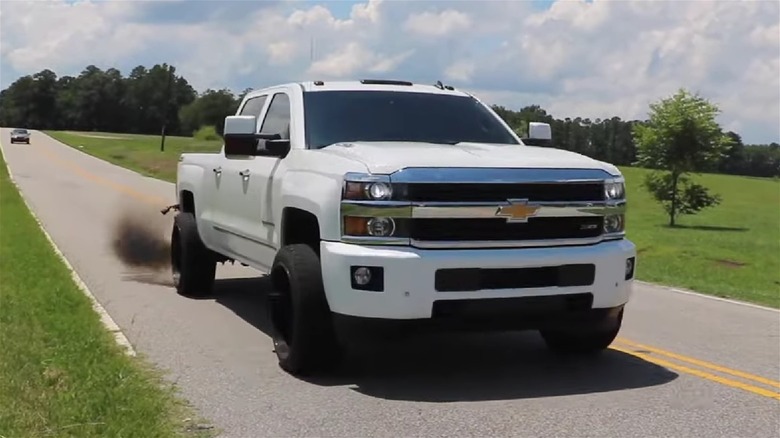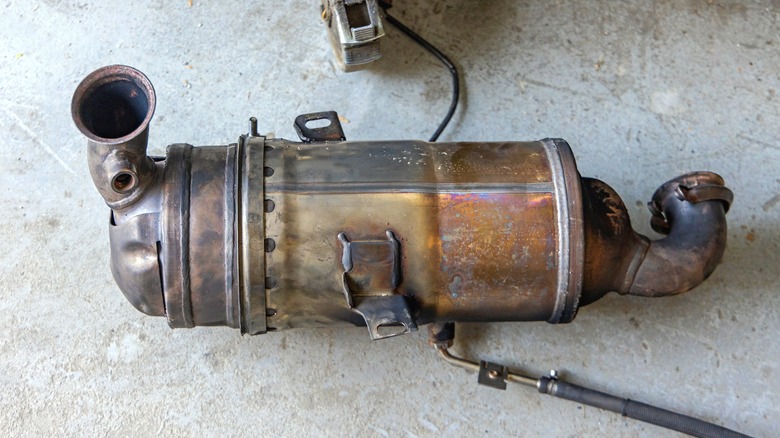What It Means To Delete A Diesel Truck (And Why It's A Bad Idea)
Starting in 2008, new diesel trucks were required by the EPA to include an EGR (exhaust gas recirculation system), which routes exhaust back into the combustion chamber to reduce temperatures, a DPF (diesel particulate filter), which traps and burns soot and ash particles, and a diesel nitrogen oxide filter, that reduces harmful tailpipe fumes. These tightening emission standards sought to curb not only unhealthy smog, but also reduce incidents of cancer and other health concerns, which diesel engine emissions are known to cause.
The problem was that these mandated emission reduction systems weren't reliable, creating several new issues, including reduced fuel economy. Diesel engines are more efficient than gas, so getting fewer miles to the gallon was frustrating for drivers. So, diesel owners created workarounds by removing or disabling emission control parts, and it became known as "Deleting a Diesel." It wasn't just truck owners that circumnavigated new EPA regulations, but also automakers, with examples like Volkswagen's infamous dieslegate scandal. However, there are some very good reasons not to delete a diesel today if you were thinking about doing it.
The technology got much better
Early emission control components like the diesel particulate filter (DPF) were more prone to failure than they are now, and some owners worried it was only a matter of time before it malfunctioned. With potentially unreliable parts central to the EPA emissions reduction plan, it's understandable that diesel truck drivers might want to simply remove a possibly problematic filter, rather than have it fail. According to MotorTrend, "replacing the DPF- and catalyst-equipped exhaust system on an '07-and-newer diesel is projected to approach $7,000."
Fortunately, there have been improvements made to the DPF system over the years, such as an enhanced ability to manage heat, increased airflow, and incorporating materials like ceramic, silicon carbide, or cordierite, which can handle more intense temperatures. In addition to overall better performance, DPF systems are more reliable today. A technical adviser to the North American Council for Freight Efficiency, Kevin Otto, explained to FleetOwner.com, "Most fleets will tell you that their newer trucks are doing much better than their older ones." Another example is found when looking at the most reliable Duramax diesel engines, in which the latest generation is considered among the best.
It's illegal and you'll fail a smog test
While you may own the truck, US Federal Law prohibits tampering with or removing emission reduction systems. Basically, if you're caught with a deleted diesel, you could get hit with a hefty fine of more than $5,000 per emissions defeating device. Your situation gets even worse if you are found to be selling equipment that allows for circumventing emissions controls. Per NBC News, between fiscal years 2020 through 2023, the EPA finalized over 170 civil cases and 17 criminal cases relating to emission-defeating devices.
In addition, if you reside in one of the states that require emissions testing, you'll need to successfully reinstall all the emissions systems you removed during the delete in order to pass. This also includes reverting any changes you made to the ECM (engine control module) back to the stock settings. If you live in a state like Massachusetts, which requires an emissions check as part of the annual vehicle safety inspections, you'll be required to repeat the process of returning your deleted truck back to stock every year.


